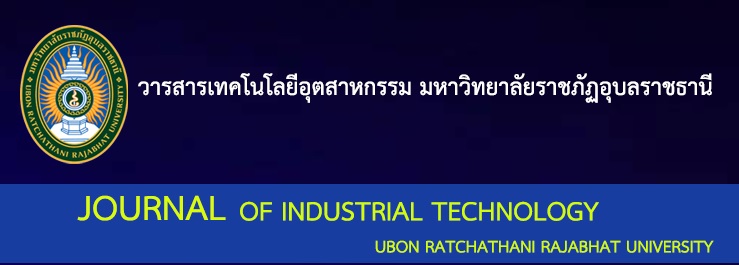A Study of Charcoal Burning Process and Properties of Briquetted Charcoal from Vetiver Grass
Main Article Content
Abstract
This purpose of this research was to study the charcoal burning process and briquetted charcoal properties from vetiver grass. The samples were Don Vetiver grass burned by the 200 liter- vertical tank. The charcoal powder from burning the vetiver grass mixed with tapioca starch as a binder. There are 5 ratios of the charcoal powder (kilograms) and the binder (liters) as followings 0.5:1, 1.0:1, 1.5:1, 2.0:1, 2.5:1, respectively. The forming process was shaped by cold-pressed processes in block shape. Then the charcoal properties were determined. The results showed that the total time for burning the charcoal is about 120 minutes with maximum furnace temperature as 830 ° C. The percentage of charcoal is 17.84 ± 0.45. The briquetted charcoals at the ratio of 2.5:1 were not able to shape. Amount of charcoal powder for mixing was directly proportional to the ash content but inverse effects on the combustible substances. However, volatile matter and fixed carbon showed no significantly differences (P>0.05). Moreover, The briquetted charcoal at ratio of 1.5:1 passed all tested requirements, showed the optimal ratio for the briquetted charcoals from vetiver grass with thermal energy of 5,335±4.95 cal/g are the highest efficiency compared to the benchmark of community standard for charcoal production.
Article Details

This work is licensed under a Creative Commons Attribution-NonCommercial-NoDerivatives 4.0 International License.
Articles published in Journal of Industrial Technology Ubon Ratchathani Rajabhat University both hard copy and electronically are belonged to the Journal.
References
[2] Phutteesakul R. The Production of chacoal briquette by coconut shell and cassava rhizome. [Thesis]. Bangkok; Srinakharinwirot University; 2010. (in Thai)
[3] Thamsirisub S, Pachana B. The study production of briquette by Pennisetum purpureum. 6th National and International Research Conference; 2015 April28-29; SuanSunandha Rajabhat University. Bangkok; 2015. p. 502-512. (in Thai)
[4] Chuaythong T, Chaichana T, Amloy S. Properties of charcoal from Areca Caterchu Linn shells.Thaksin University J. 2014; 17(3): 68-75. (in Thai)
[5] Department of Science Service. Charcoal Briquette production from agriculture material [Internet]. 2015 [cited 2012 September 10] available from: http://www.clinictech.most.go.th/online/pages. (in Thai)
[6] Tanpaiboonkul N, Budnumpetch T. Molding and binding method on properties of fuel from water hyacinth.Veridian E-Journal, Science and Technology Silpakorn University. 2016; 3(6): 86-100. (in Thai)
[7] Sutthiwilairatana L, Pakart P, Sittheesaard K. Fuel briquetting from biomass residue[Internet]. 2015 [cited 2017 September 15] available from: http://forprod.forest.go.th/forprod/ebook/ Research18/02.pdf (in Thai)
[8] Thai Industrial Standard Institute. Standard community Production Standard Per 238-2547 [Internet]. 2004 [cited 2017 September 2] available from: http://tcps.tisi.go.th/pub/tcps238_47.pdf (in Thai)
[9] Ussawarujikulchai A, Semsayun C, Prapakdee N, Pieamsuwansiri N, Chuchat N. Utilization of durian and mangosteen peels as briquette fuel. 49th Kasetsart University Annual Conference: Sciene. Bangkok; 2011. p. 162-168. (in Thai)
[10] Saueprasearsit P, Sarasartbuncha N,Yaso A. Bio-coal Production from Mimosa pigra L.In Terdtoon P, editors.The 9thMahasarakham University Research Conference;2013 September 12-13; Faculty of Public Health, Mahasarakham University; 2013. p. 410-418. (in Thai)

